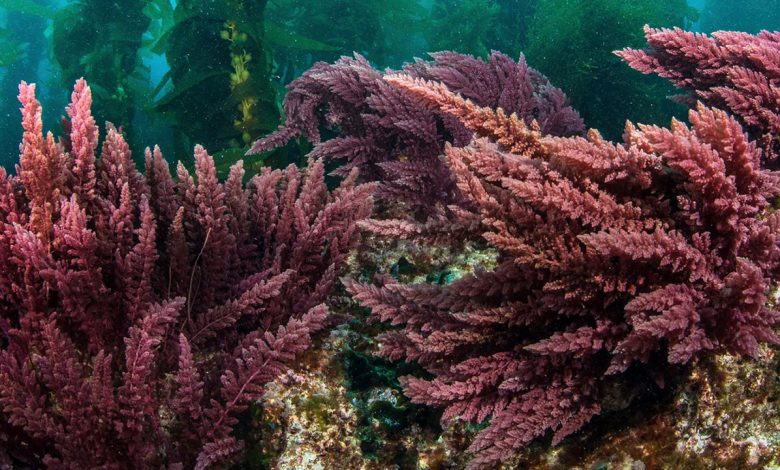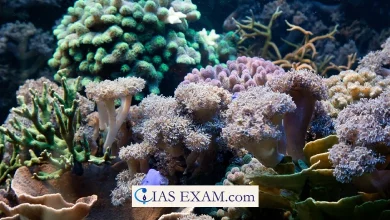Daily Current Affairs for UPSC
Methane Production using Red Seaweed
Syllabus- Environment and Ecology [GS-Paper-2]

Context– The Australian startup Rumin8 is developing a dietary supplement which inhibits the production of the methane using red seaweed as a source of synthetic material.
Key Highlights
- The firm is expected to conduct research on food supplements of livestock to lower methane emissions, that is the highest produced greenhouse gas after carbon dioxide.
Methane
- Methane (CH4) is the simplest hydrocarbon, that consists of one carbon atom and four hydrogen atoms.
- It is a colorless, odorless, and highly flammable gas, and also the main component in natural gas.
- It is a significant greenhouse gas because it is such a potent heat absorber. The concentration of methane in the atmosphere has risen by about 150% since 1750, apparently largely due to anthropogenic activities.
- Methane is the second most abundant anthropogenic GHG after carbon dioxide (CO2), accounting for 20 percent of global emissions.
Methane release in ruminants
- Agriculture is the largest single source of global anthropogenic methane (CH4) emissions, with ruminants as the dominant contributor.
- Unlike other animals, ruminants have specialized digestive systems consisting of stomachs that have four compartments, not one.
- Plant material is initially taken to rumen, the largest compartment in the stomach which is inhabited by microorganisms such as fungi, bacteria, protozoa and archaea.
- These microorganisms break down the otherwise indigestible cellulose-rich plants in order to release protein and energy for their host animal in exchange for nutrition and shelter.
- But during this process, which scientists call enteric fermentation, one particular microbe, the archaea, combines CO2 and hydrogen made by the cellulose-digesting microbes for creating methane.
Other Sources of Methane
- Agricultural methane doesn’t only come from animals, but also Paddy rice cultivation – in which flooded fields prevent oxygen from penetrating the soil, creating ideal conditions for methane-emitting bacteria – accounts for another 8 percent of human-linked emissions.
- Methane is emitted during the production and transport of coal, natural gas, and oil. Other agricultural practices, land use and the decay of organic waste in municipal solid waste landfills also contribute to methane emissions.
Emission by India
- India is presently the world’s fourth largest methane emitter after China, the United States and Russia.
- India has the world’s largest cattle population and also is the second largest rice producer, the agriculture sector emits five times as much methane as the energy sector.
- Agriculture accounts for 61% of total methane emissions, whereas India’s energy sector accounts for 16.4% and waste 19.8%, as per the Global Methane Tracker 2022.
Impacts of Methane Emissions on the Environment
- Methane is the major contributor to the formation of ground-level ozone, a hazardous air pollutant and greenhouse gas, exposure to which causes 1 million premature deaths every year.
- Over a 20-year period, methane is 80 times more potent at warming as compared to carbon dioxide.
- Methane has accounted for roughly 30 percent of global warming since pre-industrial times and it is proliferating faster than at any other time since record keeping began in the 1980s.
Methane Reduction
- CO2 stays in the atmosphere for centuries, methane breaks down quickly and most is gone after a decade, that means action can rapidly reduce the rate of global warming in the near-term.
- Human-caused methane emissions could be reduced by as much as 45 percent in the decade. This would avert nearly 0.3°C of global warming by 2045, by helping to limit global temperature rise to 1.5°C and putting the planet on track to achieve the Paris Agreement targets.
- Each year, the subsequent reduction in ground-level ozone would also prevent 260,000 premature deaths, 775,000 asthma-related hospital visits, 73 billion hours of lost labour from extreme heat and 25 million tonnes of crop losses.
Steps Taken by India to reduce Methane Emissions
- India Greenhouse Gas Program: Launched in 2012, Led by WRI India, Confederation of India Industry (CII) and The Energy and Resources Institute (TERI) is an industry-led voluntary framework for measuring and managing greenhouse gas emissions.
- The National Livestock Mission since 2014 includes feeding livestock with balanced rations that “can help reduce methane emissions from livestock”.
- The Galvanising Organic Bio-Agro Resources (Gobar-Dhan) scheme launched in 2018 and the New National Biogas and Organic Manure Programme, implemented from 2017, provide incentives to farmers for cattle waste recovery, used in the production of bio-energy.
- Several other schemes including Direct Seeded Rice, that uses less water during initial paddy cropping that can reduce methane emissions, and Waste to Energy plants that will generate biogas from agricultural, urban, industriaal and municipal solid waste, etc, will indirectly reduce methane emissions.
- Seaweed-Based Animal Feed: The Central Salt & Marine Chemical Research Institute (CSMCRI) developed a seaweed-based animal feed additive formulation that aims to deduct methane emissions from cattle.
- Anti-methanogenic feed supplement ‘Harit Dhara’ (HD): Developed by the Indian Council of Agricultural Research (ICAR), can cut down cattle methane emissions by 17 to 20%.
- Bharat Stage-VI Norms: Recently, India has shifted from BS-IV to BS-VI emission norms. As compared to the BS4, BS6 emission standards are stricter.
Global Efforts to cut methane emissions
- Global Methane Pledge: The Global Methane Pledge was launched at COP26 in November 2021 led by the United States and the European Union, the Pledge now has 111 country participants who are togetherly responsible for 45% of global human-caused methane emissions. By joining the Pledge, the countries commit to collectively reduce methane emissions by at least 30% below 2020 levels by 2030.
- New Zealand is one of the first nations to come up with policy-related solutions in October 2022, it proposed taxing the greenhouse gases that farm animals produce from burping and urinating.
- Researchers are trying to find gene-modifying techniques to curtail methane emissions in these animals. Scientists in New Zealand announced they had started the world’s first ever genetic programme to address the challenge of climate change by breeding sheep that emit lower amounts of methane.
- Use of Seaweed: 2021 study, published in the journal PLUS ONE, found that adding seaweed to cow feed can reduce methane formation in their guts by more than 80 per cent.
Way Ahead
- Farmers can provide animals with more nutritious feed so that they can be larger, healthier and more productive, effectively producing more with less.
- Scientists are experimenting with alternative types of feed to reduce the methane produced by cows and looking at ways to manage manure more efficiently by covering it, composting it, or using it to produce biogas.
- When it comes to staple crops such as paddy rice, experts recommend alternate wetting and drying approaches that could halve emissions.
- Rather than allowing the continuous flooding of fields, paddies could be irrigated and drained two to three times throughout the growing season, limiting methane production without affecting yield. That process would require one-third less water, making it more economical.





.png)



